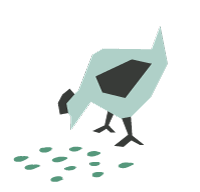No margin no mission
I’m sure you will have read something in the past that defines the vision and mission of a business, including farms. At the risk of repetition, I’m going to summarize.
A vision describes the future state of the farm. It provides insight to the question of what it is you are working towards.
Both vision and mission can, and preferably should, be put in writing as ‘statements’. However, for most farms, a vision and mission are simply understandings within the family about what gets done season by season and where they hope the business will get to at some point in an undefined future. The ‘understandings’ within the family will likely not get discussed in any formal structure. Because of this, it’s common for family members within a farm business to have quite different ideas of what it is that they’re working towards.
A mission specifies the farm’s business, its objectives and what it does to reach those objectives, such as growing crops and raising animals at a basic level. Essentially, it defines the work that gets done on a farm every year.
In the movie The Patriot, Mel Gibson’s family was brutally attacked. In retaliation, and to save his eldest son who was being taken away, Gibson and two of his other very young sons prepared to attack the soldiers who were getting away with the son they had captured. Gibson instructed the two young sons, when shooting at the soldiers, to “aim small, miss small”. The notion was that if they aimed at a body, there’s a chance they could miss. But if they aimed for a button, they may miss the button, but they would still hit the target.
Consider the connection of the movie story to a farm where the ‘target’ is the profit.
Margin equates to profit. Profit connects with cashflow. Crudely stated, no margin ultimately means no cashflow. No cashflow means no ‘mission’. Which, based on the definition of mission above effectively means no farming. I understand that this is a very simplistic summary of something that can be very complex. However, sometimes the best way to solve a complex problem, such as maximizing farm profit, is to look at the basic aspects that work together to make it complex in the first place.
I’m certainly not suggesting that the objective is to aim for a small margin of profit. I am suggesting though, that farmers invest the resources necessary get to an in-depth understanding of the financial efficiency of their businesses. When your level of understanding improves, the target becomes more defined. You also improve your ability to identify where things aren’t going well.
Farmers need to know what their margins of financial efficiency are. And then get to the detail of understanding what expenses are that are associated with the different levels of financial efficiency. The focus on that level of detail is the ‘aim small’ correlation. For every $1,000,000 in operating expenses, a 1.5% reduction per year over 25 years (with a 4% return) results in more than $625,000 in cost savings.
It’s the little things that add up. More financially efficient farms make more money.
$14 canola can tend to mask efficiency challenges and reduce the urgency of focusing on the detail of cost control. But margins inevitably narrow up. Remember … no margin no mission. For some farms, the margins will get to a point where the financial constraints become limiting … to an extent where the farm will not carry on. The time to critically examine financial efficiency and associated cost control is when there is no cashflow squeeze.
We’re now halfway through the year. How close are you, financially, to where you thought you would be at this time of year? If you don’t know, you are running the risk of disadvantaging yourself in not having the financial information necessary to make adjustments. These adjustments can strengthen financial efficiency and potentially increase the likelihood of stronger year end ‘target’ … or profit.
I’m going to guess that ‘time’ – the time to get everything done that needs to be done – is one of your most constraining resources. Another challenge may be not knowing where to start or how to go about it. No worries here. There are advisors who are keen and able to help. If you were to spend $5,000 for every $1,000,000 of operating expenses for the next 25 years, it would work out to just over $200,000 with a 4% annualized return.
That works out to a 3-1 return. Invest $200,000 that could return you $600,000. I know … easy to say on paper. But from my experience, it’s worth taking a look at what you could do, and to see what results you could achieve. At the very least, drilling down into more detailed financial efficiency analysis will result in a much better understanding of your business’ financial strengths and weaknesses.
If you would like to speak to one of our consultants about this topic contact us.



